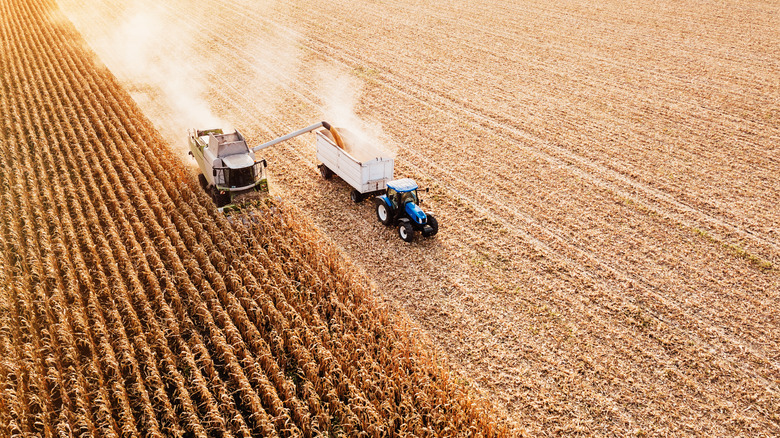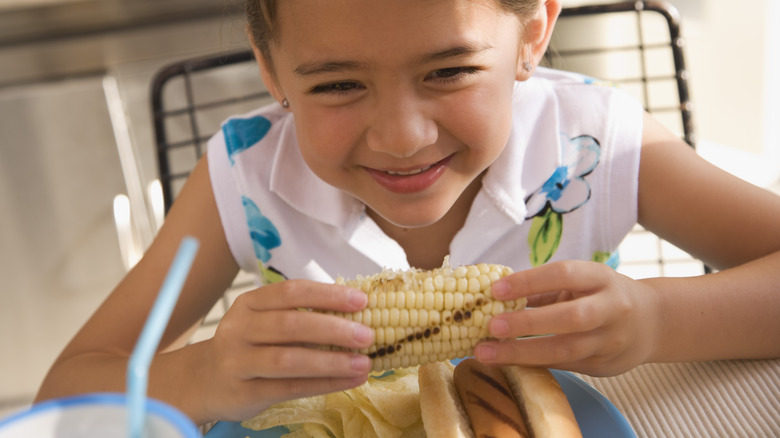What Country Eats The Most Corn Worldwide?
Though tons of crops originally came from North America and have traditionally been part of Indigenous North American cuisine — tomatoes, peppers, potatoes, and squash, to name a few — maybe the one with the farthest reach, at least in contemporary America, is corn. The history of corn and the history of U.S. cuisine itself are entirely intertwined; all you have to do is look to popcorn, succotash, or simple corn on the cob to get an inkling of how integral corn is to American food.
The importance of corn reaches far beyond U.S. borders. As a crop, it's a significant staple in large swaths of Africa and Asia.. But which countries eat and produce the most corn? While the top producer and consumer of corn likely will not shock you at all (hint: it's the U.S.), the biggest country in the world also consumes nearly as much corn as the States and some of the other countries on the list might come as a bit of a surprise.
Let's get this out of the way first: Yes, the United States is first on the list of both corn producers (over 30% of the total corn produced in 2022 and 2023) and corn consumers in total bushels (just a shade under 12 million). But the why matters here, too, because Americans use corn for pretty much everything.
Most corn production comes from the usual suspects
Corn, sometimes known as maize, is native to the Americas (Mexico specifically). The crop spread throughout North America before the arrival of Europeans and was a huge part of the Native American diet. Considering as much, it's no surprise it eventually became big for the U.S. But it's not just that we eat corn; we use it for other things, too. Corn has applications in ethanol, animal feed, and bio-based plastics thanks to its tremendous yield and versatility — and the ever-present high fructose corn syrup is where it shows up the most in modern American diets — but less than 10% of corn grown in the U.S. is eaten by Americans. In many ways, corn is a key driver of the U.S. economy.
China ranks second in total production with 24% of worldwide yield and consumption with 11.7 million bushels — no surprise since the country is so populous. But Chinese citizens don't eat much in their everyday diet; on consumption per capita, they're below the global average. India is also way below the average, even though citizens consume over a million bushels a year
If you count them as a collective, the populations within the European Union — not separated by country — come in next, barely leading Brazil; both are at just under 3 million bushels. Brazil makes sense, as dishes like pamonha and curau are stalwartly Brazilian, and corn migrated to Central and South America from Mexico long before Europeans arrived.
Corn consumption per person
But the total volume of corn isn't the only way to measure who eats the most of the stuff. By a wide margin, the most significant consumers of corn per person are Mexico, followed by South Africa. Mexico makes perfect sense here, as Mexican street corn is one of the world's most iconic dishes — and Mexico is where corn was first domesticated. Tortillas, tamales, and enchiladas; corn is probably the single underpinning feature of Mexican cuisine, which explains why Mexico ranks first per capita (but also fifth behind Brazil on total consumption).
South Africa is a little more surprising atop this list. Africa got corn later than Europe (nobody is quite sure when, although it was likely during the Age of Exploration of the 15th century onward). Still, it's since become a significant staple on the African continent, if not the primary grain staple. In particular, pap (whose name basically means "porridge") is a significant part of the South African diet, and despite the name, more closely resembles American grits.
Even if it can be a pain to shuck it, corn's place as America's pre-eminent crop isn't going anywhere. It's one of the icons of American culture, arguably more significant even than something like McDonald's.


